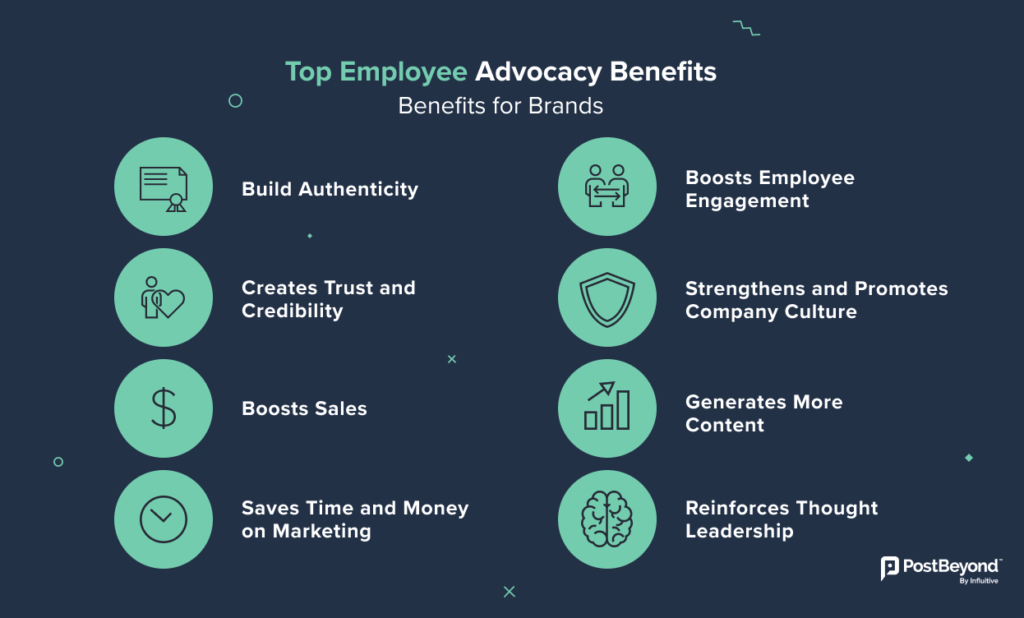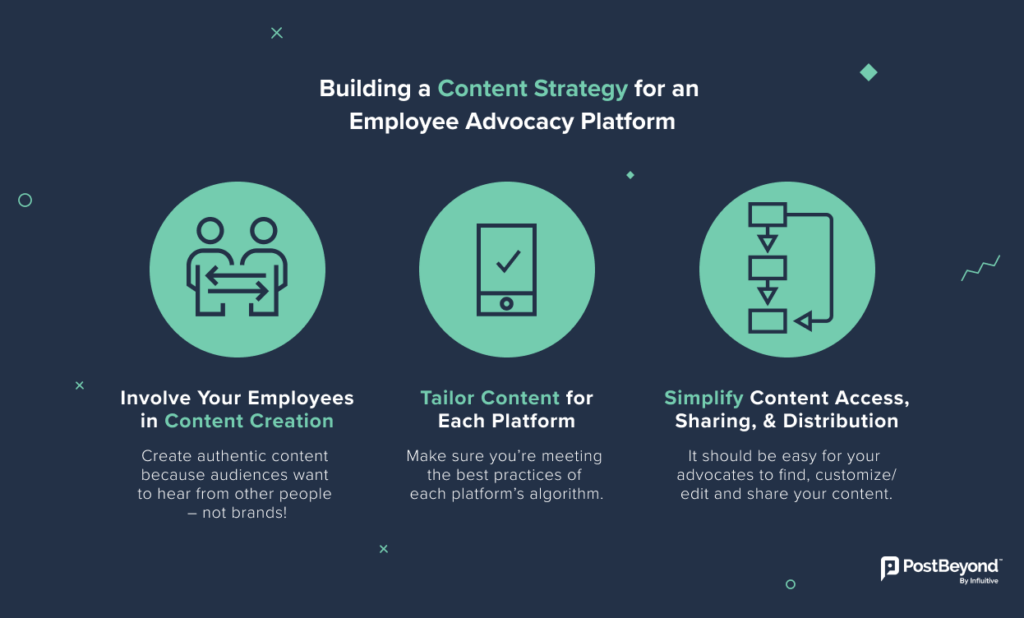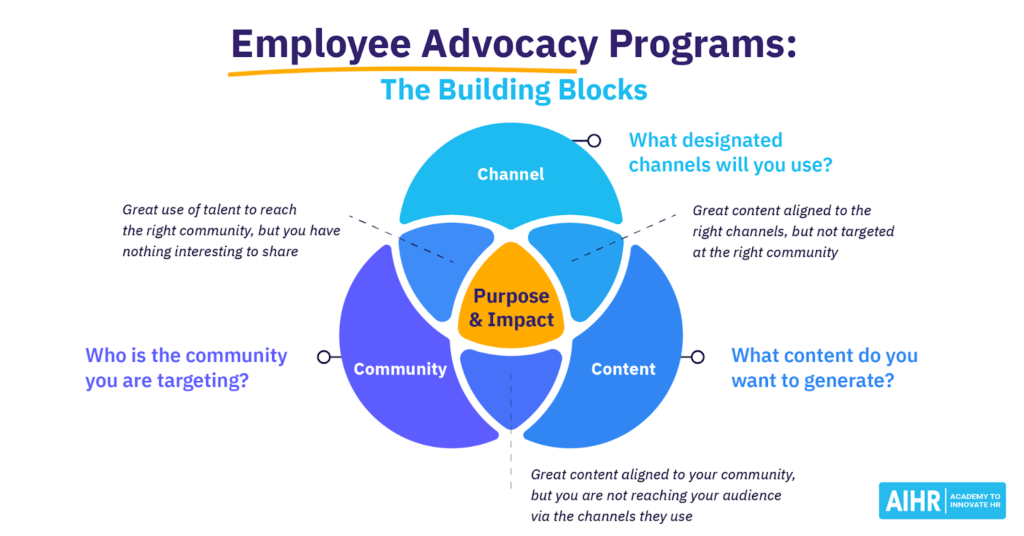Content Distribution Marketing with An Employee Advocacy Program

Do you need help to increase the visibility of your content? Do you feel like you’re constantly shouting into the void with multiple posts, blogs, and even reels, with little to no engagement or reach, even through paid ads?
It’s time to power up your content distribution strategy with an employee advocacy program. An employee advocacy program is a strategy where companies leverage their employees’ social media networks to promote their brand, products, and services. Not only does it increase your reach, but it also humanizes your brand and builds trust with your audience. This blog post will explore employee advocacy, why it’s important, and how you can set up an employee advocacy program as part of your overall content strategy.
What is Employee Advocacy?
Employee advocacy is a marketing strategy that encourages and empowers employees to promote a company’s brand, products, or services on social media and other platforms. Essentially, employee advocacy turns employees into brand ambassadors and encourages them to share positive messages about the company with their networks.

Employee advocacy programs typically involve providing employees with content to share, such as blog posts, articles, or social media updates, and offering training and support to help them become effective advocates. The goal is to amplify the reach and impact of a company’s marketing efforts by leveraging its employees’ personal networks and credibility.
- Employee advocacy can be a highly effective marketing strategy because people tend to trust recommendations from friends and family more than traditional advertising.
- By encouraging employees to share positive messages about the company, employee advocacy can help build trust and credibility with potential customers.
- In addition to advocacy marketing benefits, employee advocacy can also positively affect a company.
- Empowering employees to become advocates for the company can help build a stronger sense of community and engagement among employees, leading to increased job satisfaction and retention.
- Employee advocacy provides numerous benefits that go beyond just expanding a company’s content and distribution; it fosters positive relationships between employers and employees while building brand awareness and driving sales growth at the same time.
The Correlation Between Employee Advocacy and Content Distribution
Employee advocacy can help maximize the reach and engagement of the company’s content distribution through the following ways:
- Reach: Employees have networks that can be much larger than the company’s official social media accounts. Employees can help reach a wider audience and increase brand awareness by sharing content with their followers. This can help distribute the content to a broader audience and generate more leads.
- Engagement: Employees sharing social media content often get more engagement than the company’s official accounts. This is because people are more likely to engage with content shared by someone they know and trust. This can increase the engagement of the content and encourage more people to share it.
- Brand humanization: People tend to trust others more than companies. When employees share content on social media, it adds a human touch to the brand and can help build customer trust. This can help distribute the content more effectively and improve the brand’s reputation.
- Cost-effectiveness: Employee advocacy is a cost-effective way to promote a company’s message. Instead of spending money on advertising or influencer marketing, companies can leverage their existing workforce to spread the word. It can help distribute the content more cost-effectively and increase the ROI of the marketing campaign.
- Credibility: When employees share content on social media, it can help increase the credibility of the content as people trust personal opinions over brand advertisements. It can help distribute the content more credibly and increase the chances of sharing it.

How to Set Up an Employee Advocacy Program as Part of Your Content Strategy
You can achieve your content strategy goals and build a strong online presence by setting up an effective employee advocacy program.
Here are six steps to set up an employee advocacy program:
1. Establish clear goals and objectives
Before launching an employee advocacy program, you need to define what you want to achieve from it. Whether you intend to improve brand awareness, increase website visits, attract leads, or boost conversions? Establishing clear goals and objectives will help you measure the success of your program and adjust your strategy accordingly.
2. Choose the right social media platforms
Once you have defined your goals and objectives, you need to identify which social media platforms your employees are most active on. It is important to select a platform that aligns with your content distribution marketing goals and where your target audience is most active. For instance, if you’re a B2B company, LinkedIn might be the best platform to focus on.

3. Develop a content strategy
Your employee advocacy program’s success heavily relies on the type of content you create. You need to create content strategies that align with your business goals and resonate with your audience. Make sure to create a mix of content types, such as short testimonials, infographics, reels, and engaging social posts, to keep your employees’ social media feeds diverse and engaging.
4. Provide training and guidelines
Your employees may not be social media experts, so it’s crucial to provide them with training and guidelines on how to use social media effectively. You can conduct training sessions or create a resource library with best practices and guidelines on how to create engaging and relevant content, how to engage with their followers, and how to handle negative comments.
5. Create a gamification system
Gamification is a powerful motivator that can help increase employee engagement and participation in your advocacy program. You can create a gamification system where employees earn points or rewards for sharing content, generating engagement, and driving traffic to your website. This will encourage healthy competition and motivate employees to participate actively in the program.
6. Measure and analyze results
To ensure the success of your employee advocacy program, you need to measure and analyze your results regularly. You can track metrics such as reach, engagement, clicks, conversions, and leads generated. Use this data to identify what’s working and what’s not, and adjust your content and strategy accordingly.
The Final Word
Setting up an employee advocacy program as part of your content strategy requires careful planning, implementation, and management. You need to identify key organizational stakeholders who can advocate for your brand while creating a framework that aligns with their interests.
Training and educating employees on how to participate in the program effectively is essential. It includes providing access to relevant content and employee advocacy tools, guiding them on how to share it across different platforms correctly, tracking performance metrics, and offering incentives or rewards for their contribution. With employee advocacy becoming increasingly popular among businesses globally, it’s worth considering making it part of your marketing campaigns. With a well-planned program that leverages the enthusiasm and expertise of staff members within any organization or business sector – there are no limits to reaching new audiences!
FAQs
No, employee advocacy can be effective for any type of company. Whether you are a B2B or a B2C business, your employees can help spread the word about your brand and products.
There are several ways to measure the success of an employee advocacy program, including engagement rates on social media, website traffic from shared content, and sales generated from leads obtained through employee referrals.
It’s important to make sure that participation in an employee advocacy program is completely voluntary. If some employees aren’t comfortable sharing content on their personal accounts, they should not be pressured to do so. However, it may be helpful to offer training sessions or guidance for those who want to participate but need more information.
Yes, you should provide your employees with clear guidelines for what kind of content is appropriate to share. You should also have a system in place to review and approve content before it is shared. This will help ensure that your employees are only sharing content that is accurate and relevant.
Latest Blogs
Explore how Google’s 2025 AI search updates triggered ranking chaos. Learn actionable strategies to adapt your SEO for AI Overviews, zero-click searches, and SERP volatility. Stay ahead now.
Learn how to rank on AI search engines like ChatGPT, Perplexity, and Gemini by optimizing your content for authority, structure, and relevance. Stay ahead in AI-driven search with this strategic guide.
Explore the best healthcare SEO services for your medical practice. Improve online visibility and effectively reach more patients in need of your services.
Get your hands on the latest news!
Similar Posts

B2C Marketing
5 mins read
Top Choices for Best Content Marketing Services in B2B Industries

Artificial Intelligence
5 mins read
How A Lead Generation Specialist Can Use AI-Powered Content Funnels to Drive Conversions

Artificial Intelligence
4 mins read